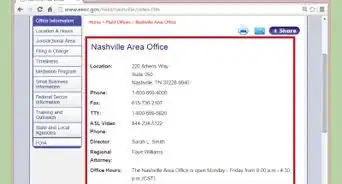This article was co-authored by James Fett. James Fett is a Lawyer based in Ann Arbor, Michigan. With over 35 years of experience, he specializes in alternative dispute resolution, civil litigation, civil rights, class actions, commercial litigation, employment litigation, and labor & employment. James earned a J.D. from The University of Michigan Law School as well as an MBA and BA from The University of Michigan. In 2001, he was awarded a Certificate of Special Congressional Recognition, and the Washtenaw Trial Lawyers Association named him Lawyer of the Year in 1996. He’s also been named a Michigan Super Lawyer by Law & Politics Magazine and one of the ten Most Outstanding Lawyers of the Year by Michigan Lawyers Weekly.
There are 10 references cited in this article, which can be found at the bottom of the page.
This article has been viewed 33,741 times.
In the United States, it is illegal for an employer to discriminate on the basis of race, color, religion, sex (including pregnancy), national origin, age, disability, or genetic information. If you have been the victim of discrimination, or if you have seen others be discriminated against, then you should report it and file a complaint with the U.S. Equal Employment Opportunity Commission (EEOC). Federal law also protects you against retaliation if you report the discrimination, so don’t worry about getting in trouble at the workplace.
Steps
Preparing to Report Discrimination
-
1Read federal law. Federal law prohibits discrimination at work on the basis of race, color, religion, sex (including pregnancy), national origin, age (if 40 or older), disability, or genetic information.[1] Federal law applies to employers with at least 15 employees; for age discrimination, the employer must have at least 20 employees.[2] [3]
- Federal law may also protect against discrimination on the basis of sexual orientation, though the law is in flux.
- It is also against the law to harass anyone based upon one of these protected characteristics. Teasing or minor isolated incidents are not prohibited. However, if the harassment is so frequent that the work environment becomes hostile, then it is illegal.[4]
- The federal government’s Equal Employment Opportunity Commission (EEOC) has been created to investigate charges of discrimination in the workplace.
-
2Search for state law. Many states and municipalities also have their own anti-discrimination laws.[5] These laws can apply to employers not covered by the federal law. They also can protect more people than the federal law. For example, many state and municipalities prohibit discrimination on the basis of sexual orientation.
- To find your state law, you can search the Internet. Type “anti-discrimination” and your state or city into a web browser. If you can’t find anything, then visit your local law library.
- States also have their own administrative agencies tasked with investigating charges of discrimination. These are called Fair Employment Practices Agencies (FEPA).[6]
Advertisement -
3Understand retaliation. If you report discrimination, then it is also illegal for your employer to retaliate against you. Retaliation includes firing, demotion, harassment, or any other form of retaliation because you filed a discrimination charge or otherwise complained about the discrimination.[7]
- Retaliation is prohibited in a variety of areas. For example, you cannot be retaliated against in hiring, firing, work assignments, pay, benefits, training, or other conditions of employment.
- You also do not need to be the victim of the discrimination to suffer retaliation. For example, you may report that your employer practices race discrimination against African Americans even though you are Latino. It is nevertheless illegal for your employer to retaliate against you for complaining about the discrimination.
- If you engage in protected activity, which includes reporting harassment, and the company takes an adverse action against you because of it, contact a lawyer, since you'll probably have an retaliation claim to make under state and federal law.
-
4Find your employment contract. To determine your first steps, you need to find your employment contract and check if there is a grievance procedure that you should follow. Many employers outline a process you should follow when complaining about harassment or discrimination. If you don’t have a copy of your contract, then ask Human Resources (HR) for a copy.
- You can also look in any employee handbooks or manuals that you have received. These sometimes outline the company’s grievance procedure.
- If you belong to a union, then you should also look at your collective bargaining agreement. These sometimes contain special procedures for union members to follow.
-
5Document the discrimination. You should gather as much evidence of discrimination that you can so that you can share it with the appropriate authorities. Try to document the harassment or discrimination as best you can. You should also document the effects of the discrimination, such as mental or physical ailments.
- Preserve communications. You should save any emails, memos, letters, evaluations, or voice mails that you believe illustrate the discrimination or were motivated by discrimination.
- Take down witness names.[8] If someone else at work observed the discriminatory conduct, then you should write down their names and contact information.
- Write down your own memories. In order to preserve face-to-face communications, you should sit down and document the incident as you remember it. Try to write down what you remember while it is fresh in your memory. Summarize what was said or done and who witnessed the incident.
- Keep medical or mental health records. These can show the impact the discrimination had on you. For example, the increased stress could have resulted in high blood pressure.[9]
- Even if you don't have any documentation, you might still have a circumstantial evidence case. One of the hallmarks for this is going to be a clean employment record followed by a sudden change in the employer’s attitude due to unknown reasons.
Reporting Discrimination to Your Employer
-
1Meet with a lawyer. Reporting discrimination to your employer can immediately put a target on your back, especially if you are complaining about a supervisor or someone else in management. Accordingly, you need to give some thought as to how to handle reporting the discrimination. An experienced employment attorney can be a great asset.
- At your consultation with the lawyer, you could discuss the problems you are having and consider the advantages or disadvantages of complaining.
- You are not required to have a lawyer either to file an internal grievance or to file a discrimination charge with the EEOC. However, you should schedule a meeting if you need advice and don’t know what to do.
- For tips on how to find a qualified employment lawyer, see Find an Employment Lawyer.
-
2Tell your supervisor. Some employers require that you meet informally with your supervisor to discuss a grievance. You will meet before you fill out any paperwork. Even if you are not required to meet with a supervisor, it might be a good idea to meet nonetheless.
- If the supervisor is the source of the problem, then you can go directly to Human Resources to pursue the grievance. Call and tell the person on the other end of the phone.
-
3Complete forms. If you were unhappy with the resolution offered by your supervisor, then you should contact Human Resources and request a grievance form to fill out. Provide all necessary information as well as copies of your supporting documentation.
- Only provide copies. Originals can get lost.
-
4Meet with Human Resources. After you complete the grievance form, you should have a meeting with someone from HR or management to discuss the discrimination. Share copies of any documentation that you have.
- Pay attention to how attentive HR or management is to your complaint. If you think that the company is not interested in rooting out discrimination or harassment, then you should proceed to filing a charge with the EEOC.
-
5Participate in an investigation. Your employer should investigate the allegation of discrimination. A typical investigation includes interviewing witnesses, reviewing documents and data, and then issuing a written report. You should make yourself available to meet with the investigator and provide any information willingly.
- At the resolution of the investigation, you should be provided with the results in writing. You may also be told what next steps you can take internally with the company.
-
6Think twice before agreeing to mediation. In order to make a discrimination charge disappear, your employer might offer mediation. In mediation, you and someone from the company will meet with a neutral third party (the mediator) to discuss possible solutions.
- There is definitely a time and place for mediation. It is in your best interest, however, to delay mediation until you file a charge with the EEOC. If you resolve your dispute before filing a charge, then you will lose the right to sue your employer at a later date. Filing a charge is a prerequisite to filing a discrimination lawsuit in court.[10]
Filing a Charge with the EEOC
-
1Choose an office to report to. If your discrimination charge is covered by both state and federal law, then you can choose to file either with the federal government’s Equal Employment Opportunity Commission (EEOC) or the state FEPA.
- Where the discrimination is prohibited by both federal and state law, then a charge filed with one office will be shared with the other office.[11] Accordingly, if you file with the EEOC, then the charge will be shared with your state FEPA.
- You shouldn’t wait to file. Federal employees only have 45 days from the date of the discriminatory action to contact an EEOC counselor. All others have at least 180 days to file a charge. If your state has a law that prohibits the same discriminatory conduct, then you might have up to 300 days.[12] In any event, you should not wait too long.
-
2File a discrimination or retaliation charge with the EEOC. There are essentially two ways to file: in person or through the mail. If you want to file in person, then visit any of the EEOC’s 53 field offices. A map at the EEOC website shows the location of its field offices. You should call ahead of time to check if you need to schedule an appointment or if the office accepts walk-ins.
-
3Write a letter. You may also file a charge by mailing a letter to the EEOC. If no field office is near you, then this might be the best option. Make sure that your letter contains the following information:[13]
- your name, address, and telephone number
- your employer’s name, address, and telephone number
- the number of employees employed there
- a short description of the events you believe were discriminatory
- when the events took place
- that illegal discrimination was the motivation for the discriminatory events
- your signature
-
4File the charge with a FEPA instead. If there is a FEPA in your state, then you have the option of filing with it. The process varies by state. In Maryland, for example, you can file a complaint with the state’s Commission on Civil Rights. There are 3 ways to file:[14]
- In person. You can visit the William Donald Schaefer Tower at 6 Saint Paul Street in Baltimore to file a complaint. Office hours for walk-ins are Mondays and Fridays 9:00 am to 3:00 pm. On other weekdays, you can meet by appointment only. You can call 1-800-637-6347 to start the complaint process.
- By letter. You can write a letter containing all of the information that a letter to the EEOC would contain. You can then mail the letter or email it.
- Mail the letter to Maryland Commission on Civil Rights, ATTN: Intake, William Donald Schaefer Tower, 6 Saint Paul Street, 9th Floor, Baltimore, MD 21202-1631.
- Email the letter to mccr@maryland.gov.
- Online. You can complete an online form by visiting https://mccr.maryland.gov/Pages/Inquiry-Start.aspx and providing the requested information.
Expert Q&A
-
QuestionIs employment discrimination hard to prove?
 James FettJames Fett is a Lawyer based in Ann Arbor, Michigan. With over 35 years of experience, he specializes in alternative dispute resolution, civil litigation, civil rights, class actions, commercial litigation, employment litigation, and labor & employment. James earned a J.D. from The University of Michigan Law School as well as an MBA and BA from The University of Michigan. In 2001, he was awarded a Certificate of Special Congressional Recognition, and the Washtenaw Trial Lawyers Association named him Lawyer of the Year in 1996. He’s also been named a Michigan Super Lawyer by Law & Politics Magazine and one of the ten Most Outstanding Lawyers of the Year by Michigan Lawyers Weekly.
James FettJames Fett is a Lawyer based in Ann Arbor, Michigan. With over 35 years of experience, he specializes in alternative dispute resolution, civil litigation, civil rights, class actions, commercial litigation, employment litigation, and labor & employment. James earned a J.D. from The University of Michigan Law School as well as an MBA and BA from The University of Michigan. In 2001, he was awarded a Certificate of Special Congressional Recognition, and the Washtenaw Trial Lawyers Association named him Lawyer of the Year in 1996. He’s also been named a Michigan Super Lawyer by Law & Politics Magazine and one of the ten Most Outstanding Lawyers of the Year by Michigan Lawyers Weekly.
Lawyer Without evidence, yeah. But there's also circumstantial evidence that can be used in some cases. For instance, if you're a black employee with the same credentials and same results for the company, but all your other white colleagues are getting raises and you're not, you might have a case. Try gathering other witnesses that can stand up for you and present your track record of performance to HR or to a lawyer to see if there's anything you can do.
Without evidence, yeah. But there's also circumstantial evidence that can be used in some cases. For instance, if you're a black employee with the same credentials and same results for the company, but all your other white colleagues are getting raises and you're not, you might have a case. Try gathering other witnesses that can stand up for you and present your track record of performance to HR or to a lawyer to see if there's anything you can do.
Expert Interview

Thanks for reading our article! If you'd like to learn more about workplace discrimination, check out our in-depth interview with James Fett.
References
- ↑ http://www.eeoc.gov/employees/charge.cfm
- ↑ http://www.eeoc.gov/laws/types/age.cfm
- ↑ http://www.eeoc.gov/laws/types/nationalorigin.cfm
- ↑ http://www.eeoc.gov/laws/types/nationalorigin.cfm
- ↑ http://www.eeoc.gov/employees/charge.cfm
- ↑ http://www.eeoc.gov/employees/fepa.cfm
- ↑ http://www.eeoc.gov/laws/types/retaliation.cfm
- ↑ http://employment.findlaw.com/legal-help-and-resources/documents-to-show-your-attorney-discrimination-harassment.html
- ↑ http://employment.findlaw.com/legal-help-and-resources/documents-to-show-your-attorney-discrimination-harassment.html





-Step-2-Version-3.webp)









-Step-24.webp)














-Step-24.webp)






































